Arris Joins ‘Virtual’ CCAP Race

Tampa – NCTC Winter Educational Conference -- Gainspeed, the startup formed by DOCSIS pioneer and Terayon Communication Systems co-founder Shlomo Rakib, has not announced an actual product that will adhere to the company’s “virtualized” vision for cable’s next-gen access platform, but it has certainly grabbed the industry’s attention.
Among them is Arris, which acknowledged here this week that it has a virtual Converged Cable Access Platform (CCAP) on the roadmap.
Although implementations will likely differ, the general idea is to virtualize the platform by distributing the processing deeper into the network and centralize the control of the network in the proverbial cloud.
But at this juncture, early implementations of CCAPs will generally be more centralized, superdense hardware platforms that combine the cable modem termination system and edge QAM functions. In addition to saving headend space and power and cooling requirements, the general idea is to put all of cable’s services on a unified platform.
“Yes, we do have a virtual CCAP plan,” Steven Krapp, CMTS product management director at Arris, said in response to questions on a broadband technology-focused panel here on Monday. “We’re developing the roadmap,” he said in a follow-up interview.
Krapp said most of that work centers around software defined networking (SDN) technology and an Arris-made controller that’s capable of monitoring thousands of individual devices that would make up a more distributed and virtual CCAP architecture.
But Arris, which reports fourth quarter earnings later today (February 19), also believes that it has time to develop a virtualized CCAP before the market needs it. In a separate interview, Krapp said the E6000, Arris’s CCAP-pointing chassis (pictured above), can handle 56 service groups per device, and is already targeting service groups of 72 and more in anticipation of coming node splits. He said Arris’s analysis shows that 200 service groups represents the “breaking point” before it makes sense to virtualize the architecture.
Multichannel Newsletter
The smarter way to stay on top of the multichannel video marketplace. Sign up below.
“But we believe we have to think about it now,” he said.
Still, Gainspeed and its virtual CCAP idea (it has not even announced a product, but privately showed a working prototype at last year’s SCTE Cable-Tec Expo) has sparked concern that today’s CCAPs are already heading toward obsolescence.
Arris isn’t buying it. "The E6000 is the right product for the market right now,” Krapp said.
The E6000 is starting off as a high-density CMTS, but Arris plans to add the edge QAM elements later this year and turn it into a fully-integrated CCAP. Krapp said Arris’s approach will allow operators to upgrade the E6000 for CCAP (as well as DOCSIS 3.1) through software upgrades.
Gainspeed sees it differently, believing that operators will have a more pressing need to distribute their architecture to support CCAP and DOCSIS 3.1, a platform that envisions an all-IP platform capable of delivering up to 10 Gbps downstream and as much as 2 Gbps upstream.
“Virtualization is entirely key to making the network scale,” while also providing a centralized, simpler control plane and bring “radical economic benefits to the market,” Gainspeed CEO Drew Perkins said.
Perkins called CCAP a “great idea,” but with the bulk of future traffic growth likely tagged for IP, he likewise wondered if the initial, more monolithic approach of the architecture will deliver “too little, too late.”
But Perkins is a huge fan of DOCSIS 3.1 and its promise to deliver fiber-like performance at palatable economics, but says operators will need to distribute the capacity on their networks if they are to support the higher frequency ranges and modulations envisioned by 3.1.
“Coax will be able to compete with fiber for decades to come,” he predicted. As CCAP becomes virtualized, HFC will deliver an “order of magnitude better economics than fiber.”
So, when does Gainspeed expect to unleash an actual product? Perkins declined to reveal a date on stage, but said there’s a way to find out – just agree to sign a non-disclosure agreement.
